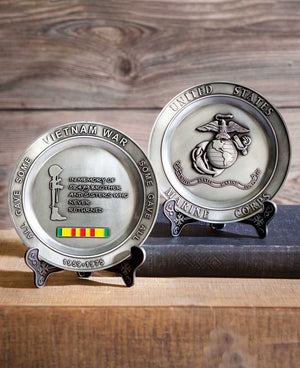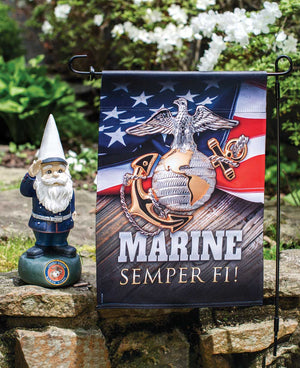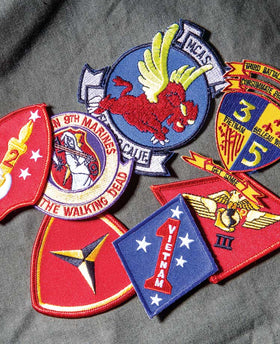Submitted by: MARINE Jim McCallum (the ole gunny)
(Spec. Issue #2), (23 Feb., 2014)
Iwo Jima Flag Raising Commemoration
Not many of you will remember this date, but you'll remember hearing about this event from your fellow MARINES and also from your Drill Instructors. Plus, it was normally discussed during some of the history lessons that used to be taught in school. It is the image of six (6) men raising raising the American Flag during the battle for the island of Iwo Jima in the South Pacific during the Second World War. The actual date of the Flag Raising on the Island was 23 February 1945, four day's after the actual battle began. Now, Iwo Jima is a volcanic Island shaped like a trapezoid with Mt. Suribachi, being the only mountain on the Island. At 546 ft. high, it is at it's southernmost tip, thereby over looking the rest of the Island to the North. At the time of the Island's invasion it was a part of the prefecture of Japan and was heavily fortified, hence the high causality count sustained by the MARINES that landed there. In 1945.
I guess at this point your asking yourself whats all this got to do with Aviation? Well, the island of Iwo Jima, although small, had three airstrips on it and it would be an ideal stepping stone for the United State military in their move toward the Island of Japan. That was because it laid halfway between the Mariana Islands (where long range American bombers were staged), and the main Islands of Japan. The primary function of the Island enclave was to act as an "Early Warning Station" allowing the Japanese to radio warnings of incoming American bombers to the Japanese homeland, Plus, it was planned by the American forces that the air strips on the Island could be used as emergency landing strips for any damaged bombers operating in the area.
Now, history indicates that there have been several accounts of who was, and who wasn't involved in this event. And it should also be known that there were actually two (2) flag raising's, on that same day. The second is the one that received such high acclaim and the photo that was taken documenting that particular event was taken by Joe Rosenthal. It later was the only photograph to win the Pulitzer Prize for Photography in the same year as it's publication. It has been regarded as the most recognizable image of the war and the MARINE CORPS, and more than likely, the most reproduced photograph of all times.
But, it was not with out controversy, it has been recorded that there were 5 MARINES and one (1) Navy Corpsman depicted in the picture. Their name's were Harlon Black, Franklin Sousley, and Michael Stank who were all killed in one way or the other and then there were the other three men and their names were Rene Gagnon, Ira Hayes and Corpsman, John Bradley who all rose to celebrity status after the photo was taken, and they were identified. It should also be noted that the capture of Suribachi on February 23rd, 4 days after the battle and it did not conclude the effort to capture the island, that task continued for many days, and the island would not be declared "secure" until 31 days later on the 26th of March, 1945.
I'm not going to delve into all the trials and tribulation that later transpired with the surviving participants only to say that there were some complications and all the problems were finally worked out. But, that's a story in itself. I should also state that I have been to Iwo Jima in early 1956 with "A" Co, 3 rd. Eng. Bn., and it was not a pleasant place. While digging in we discovered many different items left behind by our fellow MARINES in 1945, some still intact. It was a very moving experience…
From all this turmoil there is only one name that has seemed to float to the surface, and that is Ira H. Hayes. Sometime after the war, Ira would return and subsequently die in the town of Sacaton, AZ where he was overcome with depression brought on by survivors guilt and he became an alcoholic. His passing at the age of 32 in 1955 was memorialized in a folk song and sung by Johnny Cash in 1964. It was called "The Ballad of Ira Hayes" and it was written by Peter LaFarge. It might also be noted that Rene Gagnon's last years were not any better and he died at the age of 54 in 1979, as an alcoholic.
All this history is remembered and celebrated annually in the town of Sacaton, AZ, in the Gila River Indian Community on the 4th Saturday of Feb. Native Americans representing many different tribes from around the Country and all branches of the Services descend on Sacaton as do a large number of Veteran MARINES and their families to help commemorate this moment in American History. It is truly a moving spectacle dedicated to American Patriotism and of course one of the MARINES involved in the original event, Ira Hayes. Which just so happens to have lived in this town prior to his death.
I'm not going to delve into what and who all were in the Parade, but I would urge any and all MARINES to some day put this event on your calender or, "to do" list and attend. Especially, if you live in a cold climate. I guarantee that you will never regret it. But, bring a light jacket because it gets a little cool in the morning.
God Bless all MARINES and other Defenders of our Freedom
SEMPER FI
See more images from the parade at:









Leave a comment